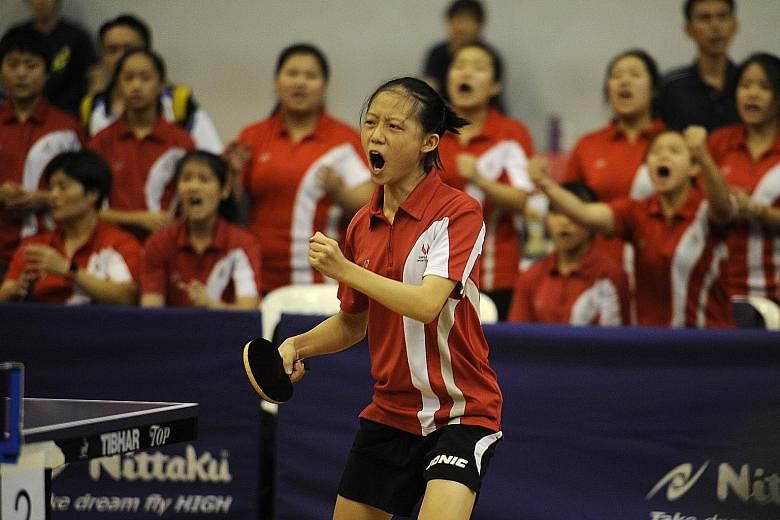The Singapore Table Tennis Association (STTA)'s ambition to field local-born players at the Olympics is laudable - and not impossible.
But for several familiar with the international and local table tennis scenes, the STTA must back this endeavour with meticulous planning and commitment - and not all are convinced it can pull it off.
Former Singapore women's team coach Liu Guodong said it is clear that producing local-born paddlers for the big stage is not mission impossible. He should know. He is the coach of Hong Kong, which has similar population, socio-cultural constraints (like a heavy emphasis on education) to Singapore and until very recently also relied on foreign sports talent.
He pointed to world No. 15 Doo Hoi Kem, 19, and No. 23 Lee Ho Ching, 23, as examples of Hong Kong's success stories. They took over the mantle from China-born veterans like Tie Yana and Jiang Huajun, qualifying for the Rio Olympics and making the round of 16 in their maiden Games before succumbing to opposition from China.
"Grooming a local-born player is not something you say and hope that it happens by chance," said Liu. "You need to identify kids when they're about seven or eight, and you need at least 10 years for them to get to a competitive level in the world. You need to know exactly what your plans are - who these kids are and what you plan to do with them."
The STTA announced new high performance strategies on Tuesday, declaring an intent to groom a new batch of athletes to succeed players like China-born Zhou Yihan and Lin Ye within "four to eight years" and to field a local-born talent at the Olympics.
When pressed by The Straits Times for details of its plans, the STTA said that it has identified four girls all aged 16 to join its intermediate squad from next year. They are Eunice Lim (world No. 518), Tan En Hui (No. 582), Zhang Wanling (No. 625) and Zermaine Nicole Lew (unranked). Lucas Tan, a 17-year-old boy who is unranked, has also been invited.
It added that three boys and three girls from the Singapore Sports School's School Within A School programme will also be put through " an intensive training and competition programme for (the) next two years".
Liu, however, feels it will be an uphill task for this batch of local-born aspirants, given where they stand internationally now.
He said: "Players should have had some sort of breakthrough on the international circuit by the time they're about 16."
Veteran coach Zhou Shusen, who was at the helm of the Singapore women's team when they won the world team title in 2010 and two bronze medals at the 2012 Olympics, did not mince his words.
He said: "If you're already around 16 and you haven't even started playing in senior-level tournaments, it's game over. It's tough to hear, but it's the reality.
"Singapore has always said it wants to groom local-born players, but a lot of resources must be put in and the youth development system must improve."
With world No. 6 Feng Tianwei booted out, the STTA said it will rely on China-born Yu Mengyu, 27, Yihan, 22 - who played at the Rio Games - Lin Ye, 20, and Zeng Jian, 19, for the next two Olympic cycles, "with an immediate focus on improving their world rankings".
Yu is the highest ranked of the group at No. 13, followed by Zeng (18), Zhou (31) and Lin (71).
This would require them to compete regularly on the International Table Tennis Federation (ITTF) professional circuit to pick up ranking points, something the STTA has always done for its elite paddlers.
With limited entries - each association can field up to six in an event - and resources, the STTA faces a tricky job balancing the need to boost the rankings of the national team's current nucleus while also giving its local-born up-and-comers the exposure they need.
So far, opportunities to take part in ITTF senior-level events have been few and far between - if any - even for its brightest local-born women players. But Clarence Chew of the men's team, who seems the likeliest local-born to make the Olympics for now, has had regular competition and will continue to take part in six to eight stops a year.
In response to queries about how it intends to manage this, the STTA said the current group of China-born players will "lead the women's team in championships and major Games" and will "also train with our local players during training". It also promised to engage short-term and long-term sparring partners to train with the intermediate squad.
Still, for those within the fraternity who have for years heard the STTA champion "youth development" only to be disappointed, confidence has become a rare commodity. Said a parent, who declined to be named and whose child was part of the national youth team: "A lot more parents these days are actually very willing to let their child choose sports over studies. But when you see so many examples of talented children go into the system before you, but end up being let down and leave the sport, or when you don't feel confident that the management is transparent or invested, people can't help but walk away."


